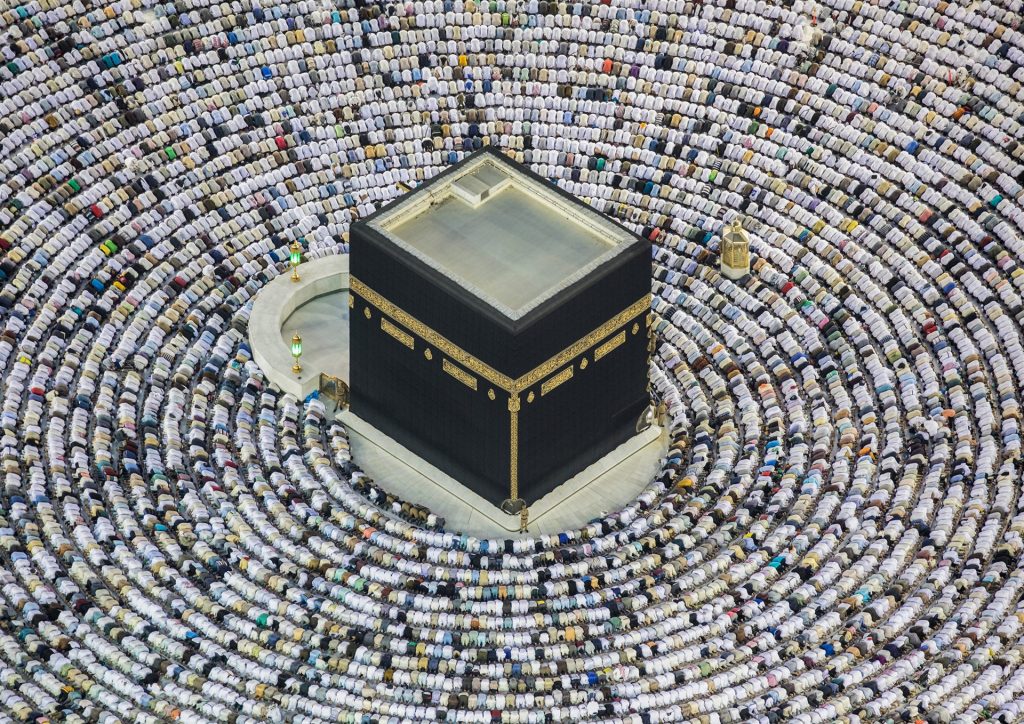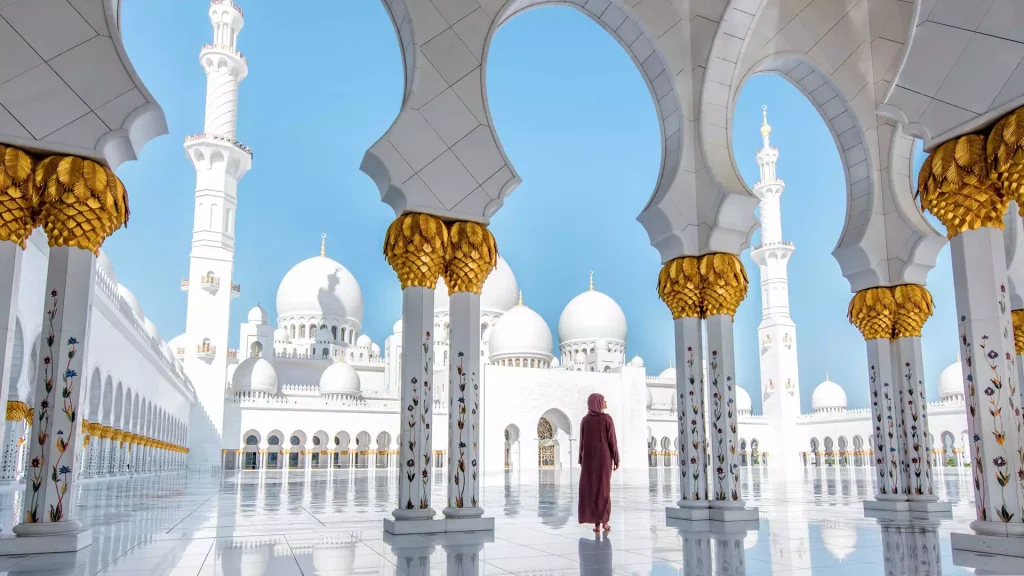Marble domes and luxurious gold features. Sky high minarets coupled with some of the world’s largest chandeliers. Mosques are renowned around the world for their opulence and architectural beauty but none-more-so than those found in the Middle East.
From Saudi Arabia to Kuwait through to Oman and Qatar, the region houses some of the most striking mosques that’ll have you filling your phone’s photo gallery trying to capture their beauty.
With so many to choose from, we’ve rounded up nine of our favourites that you must visit next time you’re in the region. But there’s more, so if you’re interested to see more in a part two, be sure to let us know:
Masjid al-Haram, Mecca, Saudi Arabia

The grandest, most visited and most significant mosque in Islam is Saudi Arabia’s Masid al-Haram also known as the Sacred Mosque or the Great Mosque of Mecca.
Built in the year 638, Masid al-Haram is believed to be the first mosque ever constructed, and as such holds great significance amongst Muslims around the world. So-much-so that every year, the Great Mosque welcomes millions of worshippers during the Hajj and Umrah pilgrimages.
The mosque’s most distinguishable feature is the central courtyard where pilgrims will circle stone building in the centre called Kaaba as part of their religious rituals.
The mosque has undergone changes over the years including a recent expansion to accommodate more worshippers which according to Saudi Arabia’s tourism leaders, will exceed 15 million in 2025.
Al-Masjid an-Nabawi, Medina, Saudi Arabia

Following the grant Masjid al-Haram is Al-Masjid an-Nabawi which is the second largest and holiest site in Island.
Also known as the Prophet’s Mosque, Al-Masjid an-Nabawi was constructed by the Islamic prophet Muhammed and houses his tomb in the featured structure known as the Green Dome.
Although established in the year 623, the mosque has undergone upgrades and enlargements to host up to one million worshippers at a time.
Standing at 104m high, the mosque’s four minarets stand out in the forefront of Medina’s hillside, making it one of the distinguishable places of worship in the Middle East.
Zayed Grand Mosque, Abu Dhabi, UAE

While it may not have the history of the first two, this mosque has ‘grand’ in its name for a good reason.
Nestled in the heart of Abu Dhabi’s is the 40,000 capacity Sheikh Zayed Mosque which is often described as a visual masterpiece with its 82 marble white domes and 1,000 columns.
Inside, the mosque demands attention and appreciation with 24-carat-gold gilded chandeliers and the world’s largest hand-knotted carpet.
Abrahamic Family Houses, Abu Dhabi, UAE

The newest and quickly embraced Mosque in the Middle East is Abu Dhabi’s Eminence Ahmed El-Tayeb Mosque.
The Mosque was constructed between 2019-2023 and sits amongst a Church and a Temple as part of the interfaith complex on Saadiyat Island called the Abrahamic Family House. The complex was designed to reinforce the UAE’s values of peaceful coexistence, diversity and dialogue.
Eminence Ahmed El-Tayeb Mosque’s design is minimal with a mostly white appearance, seven arches that represent the importance of the number seven in Islam and can accommodate 300 worshippers.
Sultan Qaboos Mosque, Muscat, Oman

When a Sultan wants a grand mosque for his country, then he shall get one! That was certainly the case for Oman’s Sultan Qaboos bin Said Al Said who declared in 1992 that he would give the Sultanate their own glorious place of worship.
And so, he did.
In May 2001, he inaugurated the Sultan Qaboos Mosque in the capital city of Muscat which awed attendees with five minarets built around the mosque – the largest standing at 90m high. A series of sandstone archways lead to a central dome that rises to 50m above the prayer hall inside where the second largest hand-knotted carpet can be found.
Keeping in line with the ‘grand’ theme, the mosque’s praying hall features the world’s second largest chandelier hanging 14m down. The mosque is capable of hosting 20,000 worshippers and has since become a must-do in Oman.
Masjid Bab Al Salam, Muscat, Oman

You know it’s a mosque worth seeing when it makes Time Magazine’s ‘World’s Greatest Places 2024’.
That’s the accolade Oman’s Masjid Bab Al Salam received this year for being “a minimalist wonder bathed in natural light, with a more restrained aesthetic than some of the region’s lavishly appointed religious spaces, leaving visitors to turn their thoughts inward”.
Meeting the incredibly accurate description, Oman’s Masjid Bab Al Salam is the opposite of the more lavish and opulent mosques in the region with a simplistic yet distinctive blush-coloured, circular exteriors. Inside, the mosque’s dome has an ethereal-type beauty whereby its white walls and red carpet are illuminated by a thin floor-to-ceiling window that replaces the mihrab – usually a niche in the wall that points worshippers in the direction of Mecca.
Sultan Ahmed Mosque, Istanbul, Turkey

The Sultan Ahmed Mosque in Turkey goes by the nickname Blue Mosque and when you see it, you’ll completely understand why.
The peaks of the mosque’s six minarets are blue, as are the roofs of the central dome, its surrounding four semi-domes and other outdoor structures. Inside takes on the same colour-scheme with floral motifs painted in predominantly blue colours.
Was blue Ahmed I’s favourite colour when he ordered the mosque’s construction in 1609? Maybe or maybe it was just the trending colour during the Ottoman Empire. Either way, the distinctive exterior along with the mosque’s grand size and popularity earned it a listing as a UNESCO World Heritage as a ‘Historic Area of Istanbul’.
Mamluki Lancet Mosque, Al-Masayel, Kuwait

The breathtaking Mamluki Lancet Mosque in Kuwait is where ancient traditions meet modern magic. This stunning sanctuary is more than just a place of worship – it’s an ode to Islamic heritage, infused with contemporary flair.
Inspired by intricate Moqarnas geometry and the symbolic Islamic Star, the mosque’s five interconnected masses resonate with the five daily prayers – and invitation to connect with the divine.
As you enter, you’ll be enchanted by the grand wooden doorway, majestic minaret, and delicate lancet arches that dance across the facade. Inside, Quranic calligraphy comes alive in elegant Thuluth script, while natural light pours in, casting ethereal rays on the walls. The adaptable design aimed to provide a sense of community, with flexible prayer spaces and serene areas for contemplation.
Mosque of Light, Dubai, UAE

A stunning sanctuary crafted by pioneering architect Sumaya Dabbagh, this contemporary mosque is a masterclass in minimalism, using natural light, geometric patterns, and thoughtful design to transport worshippers from the bustling outside world to a profound inner calm.
As one of the UAE’s first mosques designed by a woman, it’s a beautiful tribute to the community and the late Mohamed Abdulkhaliq Gargash.
As you step inside, the journey begins…
Natural light dances through triangular patterns, creating an ethereal atmosphere. The mosque’s simple yet striking design strips away distractions, inviting intimacy with the sacred. With “prayer requires presence” in mind, Sumaya designed every detail that allowed worshippers to “quiet the mind and find inner calm.” From the calligraphy-wrapped prayer hall to the double-skin dome filtering soft light – this sacred space embodies harmony and spirituality.
Education City Mosque, Doha, Qatar

Located within Hamad Bin Khalifa University’s College of Islamic Studies, this award-winning mosque (American Architecture Prize, RIBA nomination, and WAF Best Religious Building) is where faith meets knowledge.
Iraqi architect Taha al-Hiti’s masterpiece features soaring minarets adorned with vertical calligraphy, guiding your gaze heavenward. Five pillars support the mosque, symbolizing Islam’s five pillars: Shahada, Salah, Zakat, Sawm, and Hajj.
The stunning space can host 1,800 worshippers in its main hall and 1,000 in its serene courtyard. Outside, you’ll discover a tranquil oasis where four streams flow into a central garden, representing the Qur’an’s four rivers of Paradise: water, honey, milk, and wine. There’s also the Qur’anic Botanic Garden which blooms with plants mentioned in the Holy Qur’an and native Qatari flora, showcasing harmony and diversity. More than a place of prayer, this is a hub for community events, knowledge, and growth.



